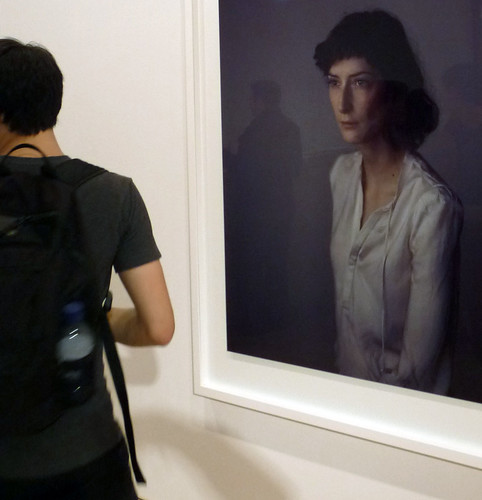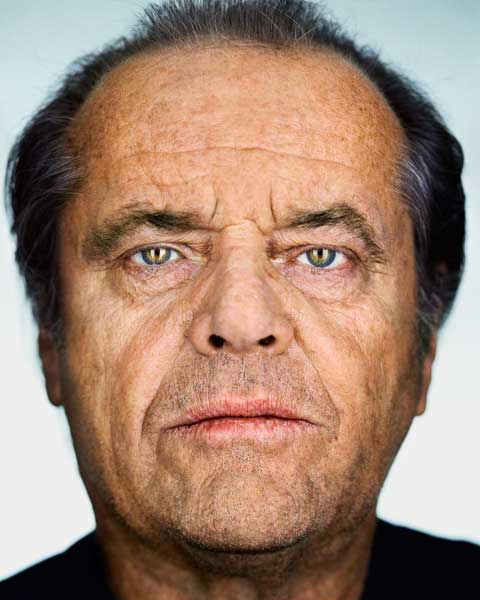The Summer 2010 issue of Aperture has a feature on British photographer Richard Learoyd. Learoyd produces compelling images, mainly simple portraits, using a very primitive and unique method of image making. The word camera means "room" in Latin, and the original prephotographic cameras were camera obscuras, rooms or smaller chambered devices that projected an outside image onto a wall or screen, from which tracings were often made. Learoyd captures his images directly onto Ilfochrome photographic paper using one of these room-sized camera obscuras. Since there is no intermediary negative, and the prints are made with a 1:1 camera, each portrait is a one-off and life-sized or larger.

These portraits are studies in simplicity. The subjects are well chosen, people of unconventional beauty, simply posed and perfectly lit against a gray background. But what makes the images really striking are the optical characteristics of the photographic process used. Large cameras inherently have a very shallow depth of field, so in these pictures just the subject's face, with perhaps a hand or arm on the same plane, is sharply focused. And because these are not enlarged from an intermediate negative, this narrow in-focus plane is exceptionally sharp and detailed.

Erika 2007 [click to enlarge]
Unfortunately, small Web reproductions fail to convey the astonishing weight, density, mass, volume and dimensionality that this process produces. The small print reproductions in Aperture are compelling; in life, they must be staggering. You've never portraits like these. Unfortunately, as Peggy Roalf in Aperture notes, "The nature of film photography today generally excludes any sense of the surface from its describable qualities."
Learoyd himself says that he working in the tradition of daguerreotypes, "those nonreproducable photographic objects whose multiplaned surface and miraculous depth of field fascinate me. . . . [Y]ou see the object before the illusion. With my pictures, the illusion is very strong and breaks suddenly, and then only momentarily, which is something I like." The same qualities can been seen especially in modern daguerreotypes by artists like Chuck Close.

Bob Holman by Chuck Close [click to enlarge]
Martin Schoeller works in color film but gets the same aesthetic by likewise using a large (8x10 inch view) camera. These very large film/plate/obscura print formats can reproduce micro-transitions in tone and contrast, i.e., detail, that smaller formats cannot.

Jack Nicholson by Martin Schoeller
Because this acute dimensionality focuses on the eyes and face, the illusion produced is one of intense intimacy. Rarely are we so physically close to a stranger that every blemish on their face becomes a compelling visual subject. And we would never examine a stranger so closely; even if suffered by the subject, it would feel voyeuristic. But says Learoyd, "I think that maybe my search for detail or perfection in my photographs is a desire to illuminate imperfection and humanness. The invitation to scrutinize another, which is undoubtedly in my work, inevitably highlights the loneliness of the soul and the depressing isolation of the human condition. After all, who do we get to look at so closely, so carefully that the pores of their skin and the meniscus of liquid under their eyes are visible? It is the opportunity to look without embarrassment—as we do with our children or lovers."

These portraits are studies in simplicity. The subjects are well chosen, people of unconventional beauty, simply posed and perfectly lit against a gray background. But what makes the images really striking are the optical characteristics of the photographic process used. Large cameras inherently have a very shallow depth of field, so in these pictures just the subject's face, with perhaps a hand or arm on the same plane, is sharply focused. And because these are not enlarged from an intermediate negative, this narrow in-focus plane is exceptionally sharp and detailed.

Erika 2007 [click to enlarge]
Unfortunately, small Web reproductions fail to convey the astonishing weight, density, mass, volume and dimensionality that this process produces. The small print reproductions in Aperture are compelling; in life, they must be staggering. You've never portraits like these. Unfortunately, as Peggy Roalf in Aperture notes, "The nature of film photography today generally excludes any sense of the surface from its describable qualities."
Learoyd himself says that he working in the tradition of daguerreotypes, "those nonreproducable photographic objects whose multiplaned surface and miraculous depth of field fascinate me. . . . [Y]ou see the object before the illusion. With my pictures, the illusion is very strong and breaks suddenly, and then only momentarily, which is something I like." The same qualities can been seen especially in modern daguerreotypes by artists like Chuck Close.

Bob Holman by Chuck Close [click to enlarge]
Martin Schoeller works in color film but gets the same aesthetic by likewise using a large (8x10 inch view) camera. These very large film/plate/obscura print formats can reproduce micro-transitions in tone and contrast, i.e., detail, that smaller formats cannot.

Jack Nicholson by Martin Schoeller
Because this acute dimensionality focuses on the eyes and face, the illusion produced is one of intense intimacy. Rarely are we so physically close to a stranger that every blemish on their face becomes a compelling visual subject. And we would never examine a stranger so closely; even if suffered by the subject, it would feel voyeuristic. But says Learoyd, "I think that maybe my search for detail or perfection in my photographs is a desire to illuminate imperfection and humanness. The invitation to scrutinize another, which is undoubtedly in my work, inevitably highlights the loneliness of the soul and the depressing isolation of the human condition. After all, who do we get to look at so closely, so carefully that the pores of their skin and the meniscus of liquid under their eyes are visible? It is the opportunity to look without embarrassment—as we do with our children or lovers."
No comments:
Post a Comment